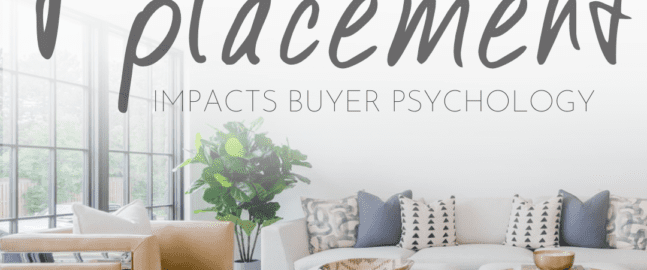When it comes to selling a property on the real estate market, first impressions are everything. Picture this: a potential buyer steps into a sunlit living room, the gentle curve of a sofa guiding their gaze towards a grand bay window that frames a postcard-perfect view. It’s not just the architectural charm that captivates – it’s the psychological dance orchestrated by the staging furniture that completes the scene, tapping directly into the buyer’s emotions and aspirations.
Lets look at the the subtle yet significant art of furniture placement, examining its profound effect on prospective buyers’ reactions and, ultimately, a property’s sellability. We’ll explore three foundational principles – First Impressions Matter, Flow and Functionality, and Creating Focal Points – that, when applied with precision, help transform a space from mere shelter to a compelling, aspirational vision.
First Impressions Matter: Setting the Stage for Emotional Engagement
It takes just a few seconds for a viewer to form an impression of your property, and these primal judgments can be hard to shake. The entryway, your home’s handshake, should exude welcome and warmth. A cluttered vestibule can signal subconscious red flags to a visitor, implying a lack of care or an uninviting atmosphere.
Paving the Way with an Inviting Entry
A well-arranged entryway plays several critical roles – it provides a glimpse of the property’s character, sets the tone for the viewing, and, importantly, eases the transition from public to private space. Mirrors, a console table with a couple of artful accents, and well-placed lighting can expand the perceived size of the entry, making it more inviting.
The Impact of Arrangement
When it comes to the living areas, it’s imperative to ensure furniture compositions both underscore the room’s function and enhance its proportions. Overstuffed couches in a cozy den beckon, while a meticulously spaced dining set suggests convivial meals and cherished celebrations. The strategic arrangement also plays to the symmetrical preferences of the human brain, which can convey a comforting sense of order and attractiveness.
Size, Scale, and Sunlight
Striking a balance between bulky furniture and the room’s dimensions is crucial. Rooms furnished with pieces that are either too large or too small can feel off-kilter and less appealing. Likewise, consider the natural light patterns and aim to diffuse the glow with soft textures and strategic placement, accentuating the space’s warmth and livability.
Flow and Functionality: The Navigation of the Subconscious
A property’s layout and flow can either ease or frustrate a buyer’s exploration. A haphazard hodgepodge of furniture can disrupt the subconscious flow of traffic through the home, while skillful arrangement contributes to an intuitive, pleasure-filled passage.
Laying the Right Tracks
Ideal pathways are clear and uninterrupted, guiding the viewer purposefully from one area to the next. Positioning items in a way that suggests – or enforces – the natural paths through your home will ensure a harmonious, uncluttered experience that keeps the focus on the space’s features and potential.
The Balance of Style and Substance
Furniture has to be as functional as it is stylish. From loveseats that perfectly partition a room to bookshelves that delineate a home office, every piece must contribute to the functionality of the space. Buyers respond positively to furniture arrangements that make the most of every square foot, showcasing a room’s flexibility and livability.
Creating Focal Points: The Art of Drawing the Eye
Focal points are the anchors that ground a room’s design and engage its occupants. Whether it’s a majestic fireplace, a breathtaking art piece, or a panoramic window, the furnishings must connect and frame these features to powerful effect.
Harnessing the Focal Power
Big or small, every room deserves a focal point. Strategic groupings around these hotspots ensure they’re not only noticed but become part of a cohesive, inviting whole. The placement of furniture can do wonders for drama, too. Chairs and ottomans that encourage people to come together and enjoy the fire, for instance, can be the difference between seeing a functional feature and envisioning a living experience.
Symmetry and Asymmetry in Balance
While a symmetrical layout can bring a sense of classic harmony, an asymmetric arrangement can add dynamism and modern flair. Consider the implications of your property’s overall style and the message the layout or combination of the two styles sends. In any case, ensure both symmetry and asymmetry serve to highlight focal points and create interest, not discord.
The Power of Subtle Persuasion
In mastering the silent language of furniture placement, we tap into the psychology of home buying. We create spaces that resonate on an emotional level, igniting the imagination and fostering a connection. Real estate is about more than property; it’s about dreams, memories, and aspirations. The right arrangement of furniture can turn a house into a canvas for those visions, inviting buyers to see themselves living them.
To Toronto real estate agents and stagers, the impact is direct and tangible – faster sales, higher returns, and delighted clients. To all practitioners of the art of selling through staging, consider furniture placement as the silent salesperson in your toolkit, crafting narratives without uttering a word.
The Lux Difference
At Lux Furniture Rentals, we don’t believe in sacrificing quality. Established by an agent and stager duo, Lux meticulously curates luxurious furniture and decor items, Lux rental items are selected by designers, for designers. Using luxurious high-end furniture allows potential buyers to immerse themselves in yourperfectly designed space. Cost cutting and using discounted furniture and decor ensures a room looks inviting, renting from Lux captures buyers minds and turns your staged space into their next home. So, before starting your next staging job, connect with Lux Furniture Rentals and discover the Lux difference.


